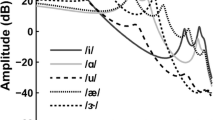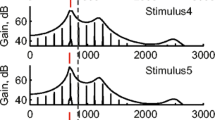Abstract
Vowel identification is largely dependent on listeners’ access to the frequency of two or three peaks in the amplitude spectrum. Earlier work has demonstrated that, whereas normal-hearing listeners can identify harmonic complexes with vowel-like spectral shapes even with very little amplitude contrast between “formant” components and remaining harmonic components, listeners with hearing loss require greater amplitude differences. This is likely the result of the poor frequency resolution that often accompanies hearing loss. Here, we describe an additional acoustic dimension for emphasizing formant versus non-formant harmonics that may supplement amplitude contrast information. The purpose of this study was to determine whether listeners were able to identify “vowel-like” sounds using temporal (component phase) contrast, which may be less affected by cochlear loss than spectral cues, and whether overall identification improves when congruent temporal and spectral information are provided together. Five normal-hearing and five hearing-impaired listeners identified three vowels over many presentations. Harmonics representing formant peaks were varied in amplitude, phase, or a combination of both. In addition to requiring less amplitude contrast, normal-hearing listeners could accurately identify the sounds with less phase contrast than required by people with hearing loss. However, both normal-hearing and hearing-impaired groups demonstrated the ability to identify vowel-like sounds based solely on component phase shifts, with no amplitude contrast information, and they also showed improved performance when congruent phase and amplitude cues were combined. For nearly all listeners, the combination of spectral and temporal information improved identification in comparison to either dimension alone.










Similar content being viewed by others
References
Alcántara JI, Moore BCJ (1995) The identification of vowel-like harmonic complexes: effects of component phase, level, and fundamental frequency. J Acoust Soc Am 97:3813–3824
Alcántara JI, Holube I, Moore BCJ (1996) Effects of phase and level on vowel identification: data and predictions based on a nonlinear basilar-membrane model. J Acoust Soc Am 100:2382–2392
American National Standards Institute (2004) Specifications for audiometers (ANSI S3.6-2004). American National Standards Institute, New York
Baer T, Moore BCJ, Gatehouse S (1993) Spectral contrast enhancement of speech in noise for listeners with sensorineural hearing impairment: effects on intelligibility, quality, and response times. J Rehab Res Dev 30:49–72
Bleeck S, Ives T, Patterson RD (2004) Aim-mat: the auditory image model in MATLAB. Acta Acust United with Acustica 90:781–787
DiGiovanni JJ, Nelson PB, Schlauch RS (2005) A psychophysical evaluation of spectral enhancement. J Speech Lang Hear Res 48:1121–1135
Dreisbach LE, Leek MR, Lentz JJ (2005) Perception of spectral contrast by hearing-impaired listeners. J Speech Lang Hear Res 48:910–921
Giguère CD, Smoorenburg GF (1998) Computational modeling of outer hair cell damage: implications for hearing aid signal processing. In: Dau T, Kollmeier B, Hohmann V (eds) Psychophysics, physiology and models of hearing. World Scientific, Singapore, p 155–164
Glasberg BR, Moore BCJ (1990) Derivation of auditory filter shapes from notched-noise data. Hear Res 47:103–138
Glasberg BR, Moore BCJ (2002) A model of loudness applicable to time-varying sounds. J Aud Eng Soc 50:331–342
Gockel H, Moore BCJ, Patterson RD (2003) Louder sounds can produce less forward masking: effects of component phase in complex tones. J Acoust Soc Am 114:978–990
Leek MR, Summers V (1996) Reduced frequency resolution and the preservation of spectral contrast in noise. J Acoust Soc Am 100:1796–1806
Leek MR, Dorman MF, Summerfield Q (1987) Minimum spectral contrast for vowel identification by normal-hearing and hearing-impaired listeners. J Acoust Soc Am 81:148–154
Miller RL, Calhoun BM, Young ED (1999) Contrast enhancement improves the representation of /eh/-like vowels in the hearing-impaired auditory nerve. J Acoust Soc Am 106:2693–2708
Moore BCJ (2007) Cochlear hearing loss: physiological, psychological and technical issues, 2nd edn. Wiley, Chichester
Moore BC, Glasberg BR (2004) A revised model of loudness perception applied to cochlear hearing loss. Hear Res 188:70–88
Patterson RD (1994) The sound of a sinusoid: spectral models. J Acoust Soc Am 96:1409–1418
Patterson RD (2000) Auditory images: how complex sounds are represented in the auditory system. J Acoust Soc Jap(E) 21:183–190
Patterson RD, Robinson K, Holdsworth J, McKeown D, Zhang C, Allerhand M (1992) Complex sounds and auditory images. In: Cazals Y, Horner K, Demany L (eds) Auditory physiology and perception. Pergamon, Oxford, p 429–443
Patterson RD, Allerhand MH, Giguère C (1995) Time-domain modeling of peripheral auditory processing: a modular architecture and a software platform. J Acoust Soc Am 98:1890–1894
Peterson GE, Barney HL (1952) Control methods used in the study of vowels. J Acoust Soc Am 24:175–184
Simpson AM, Moore BCJ, Glasberg BR (1990) Spectral enhancement to improve the intelligibility of speech in noise for hearing-impaired listeners. Acta Otolaryngol Suppl 469:101–107
Traunmüller H (1987) Phase vowels. In: Schouten MEH (ed) The psychophysics of speech perception. Martinus Nijhoff, Dordrecht, p 337–384
Acknowledgments
This research was supported by grant no. R01 DC 00626 [PI: Leek] from the NIDCD. Diedesch was supported by T35 DC008764 [PI: Leek], also from the NIDCD. Support was also provided by the Department of Veterans Affairs Rehabilitation Research &Development Service [Career Development grants C6116W (Molis) and C4963W (Gallun), and Senior Research Career Scientist award C4042L (Leek)]. The work was supported with resources and the use of facilities at the Portland VA Medical Center. The contents of this article do not represent the views of the Department of Veterans Affairs or the United States Government.
Author information
Authors and Affiliations
Corresponding author
Additional information
Portions of this research were presented at the 2008 meeting of the American Auditory Society, Scottsdale, AZ, and at the 2008 International Hearing Aid Conference, Lake Tahoe, CA.
Rights and permissions
About this article
Cite this article
Molis, M.R., Diedesch, A., Gallun, F. et al. Vowel Identification by Amplitude and Phase Contrast. JARO 14, 125–137 (2013). https://doi.org/10.1007/s10162-012-0352-1
Received:
Accepted:
Published:
Issue Date:
DOI: https://doi.org/10.1007/s10162-012-0352-1




